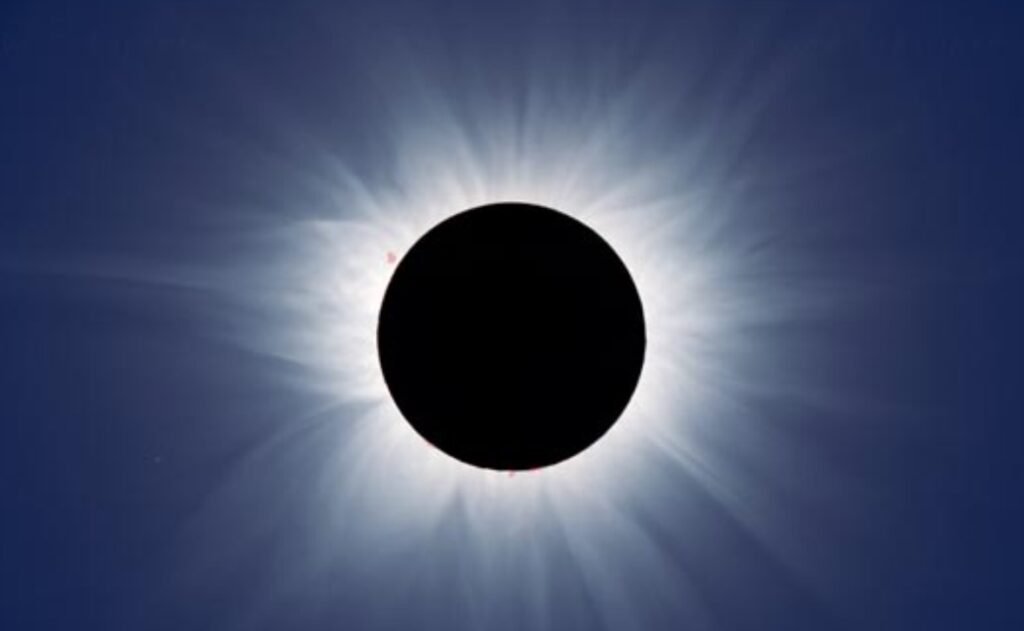On April 8, 2024, a rare and spectacular celestial event will take place over North America: a total solar eclipse. This is when the Moon passes between the Sun and Earth, completely blocking the face of the Sun for a few minutes. The sky will darken as if it were dawn or dusk, and the stars and planets will become visible. The temperature will drop, and the animals and birds will behave as if it were night.
A total solar eclipse is a once-in-a-lifetime experience for most people, as it only happens in a specific location on Earth about once every 375 years. The last time a total solar eclipse was visible in the continental United States was on August 21, 2017, and the next one will not occur until August 12, 2044. Therefore, the 2024 eclipse is a unique opportunity for millions of people to witness this awe-inspiring phenomenon.

The Path of Totality
The path of totality is the narrow strip of land where the total solar eclipse is visible. It is about 100 miles wide and stretches from Mexico, through the United States from Texas to Maine, and up through Canada. The duration of totality varies depending on the location, but the maximum is about 4 minutes and 28 seconds in Mexico.
The partial solar eclipse, where the Moon covers only a part of the Sun, will be visible in all of North America, as well as parts of Central America, South America, and Europe. The partial eclipse will last for several hours, depending on the location.
The following table shows the time that totality begins and ends in some major cities in the path of totality. These areas will also experience a partial eclipse before and after these times.
| City | State/Province | Country | Totality Begins | Totality Ends |
|---|---|---|---|---|
| Mazatlán | Sinaloa | Mexico | 11:07 a.m. PDT | 11:11 a.m. PDT |
| Dallas | Texas | USA | 1:40 p.m. CDT | 1:44 p.m. CDT |
| Little Rock | Arkansas | USA | 1:51 p.m. CDT | 1:54 p.m. CDT |
| Indianapolis | Indiana | USA | 2:06 p.m. EDT | 2:08 p.m. EDT |
| Cleveland | Ohio | USA | 3:13 p.m. EDT | 3:17 p.m. EDT |
| Buffalo | New York | USA | 3:18 p.m. EDT | 3:22 p.m. EDT |
| Montreal | Quebec | Canada | 3:29 p.m. EDT | 3:31 p.m. EDT |
| Halifax | Nova Scotia | Canada | 4:38 p.m. ADT | 4:40 p.m. ADT |
How to Safely Watch the Eclipse
Watching a total solar eclipse is an unforgettable experience, but it also requires some precautions. Looking directly at the Sun, even for a few seconds, can cause permanent eye damage or blindness. Therefore, it is essential to use proper eye protection when viewing the eclipse.
The only safe way to look at the Sun during the partial phases of the eclipse is to use special solar filters or eclipse glasses that block out most of the Sun’s light. These filters must meet the ISO 12312-2 international standard for eye safety. Ordinary sunglasses, binoculars, telescopes, cameras, or other devices are not safe to use, unless they have a certified solar filter attached.
Another safe way to watch the eclipse is to project the Sun’s image onto a screen or a wall using a pinhole projector, a cardboard box, or a pair of binoculars or a telescope. This way, you can see the shape of the Moon as it covers the Sun without looking directly at it.
During the brief period of totality, when the Sun is completely covered by the Moon, it is safe to look at the Sun without any protection. However, you must be careful to put your solar filter back on as soon as the Sun reappears, as the bright light can damage
